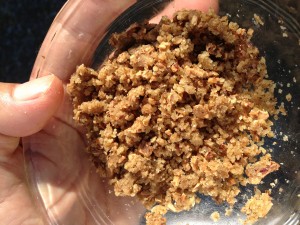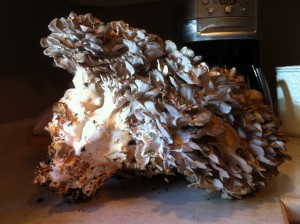
We have a few mature Shaggy Bark Hickory trees on the property at Half Hill Farm that cover the ground each Fall with lots of nut husks. The nut is viewed as the best of America’s Hickory trees, and the squirrels here love them.
 I was curious if there were any old Native American recipes using the nuts and came across some very obscure references to Cherokee Kenuche balls, ground up Hickory nuts (shell and meat) formed into a fist-sized ball that stores well through the Winter and is used on special occasions in soups by the American Cherokee Tribe. I can imagine many food uses and plan on putting a small grape-sized ball in our coffee maker in the morning.
I was curious if there were any old Native American recipes using the nuts and came across some very obscure references to Cherokee Kenuche balls, ground up Hickory nuts (shell and meat) formed into a fist-sized ball that stores well through the Winter and is used on special occasions in soups by the American Cherokee Tribe. I can imagine many food uses and plan on putting a small grape-sized ball in our coffee maker in the morning.
The aroma of Kenuche is meant to guide the ancestors back to special family gatherings where it is served as a side dish. My guess is that memories of gathering and processing the nuts with older family members who have since passed is how ancestors are connected with this very special dish. After the time consuming process of crushing the nuts earlier today, I imagine this was a task for older family members and children who helped pick out larger shells before crushing them. It’s a beautiful side dish with a rich heritage that I’m guessing has less than 40 references online, including books.


Here is how you can make your own Kenuche. We could only gather about 100 Shaggy Bark Hickory nuts because the squirrels favor this nut over everything else. I crushed each one with a hammer. Half of them were bad, so I ended up with only 50. I picked out the larger shell pieces and left the rest in a bowl. I then took a small mortar & pestle and mashed the shells and meat into an oily paste. It’s OK and easier to leave the shells, and this is how it was traditionally done (but in a large hollowed wooden bowl).


Form the resulting Hickory nut paste into a Kenuche ball using wax paper. I find wax paper keeps the oils in the ball instead of sticking to your hand. Kenuche balls are usually the size of a fist, but ours was the size of a plum. You might need 300-400 nuts for a fist-sized Kenuche ball.
You can store Kenuche in the fridge or freezer until you’re ready to use it. Our ball was about 2 ounces, so I simmered it in a half quart of water for about 30 minutes until the nut meat was dissolved into a creamy sauce. A normal sized Kenuche ball would use about a half a gallon of water. I then strained the creamy broth through a sieve and discarded the small shell pieces and added hominy to the resulting broth. We added mushrooms and let this simmer. You can add venison or pretty much anything (brown sugar and maple syrup will make a sweet version and compliment the nutty flavor), but traditional Kenuche soup is the broth with hominy.
Life is all about having the patience to crack a tough nut to get to the good stuff. If your traditional gatherings are starting to focus more on the hollow and commercial aspects of life, who’s bringing what to the table, try infusing traditions that bring people together and create memories of those who have passed. You just might bring more to the table in a humble bowl of soup than you expected.


 If you find one of these beautiful native mushrooms, and you live within about 75-100 miles of our organic farm in Woodbury, TN, we’d love to come visit and take tissue samples to replicate in our farm’s mushroom lab.
If you find one of these beautiful native mushrooms, and you live within about 75-100 miles of our organic farm in Woodbury, TN, we’d love to come visit and take tissue samples to replicate in our farm’s mushroom lab.


 Everything about growing mushrooms feels right. While producing a food with near magical health benefits, we are also sequestering larger volumes of carbon from felled trees into our soil through compost creating a multi-threaded sustainable loop that increases the health of our soil, our food and ultimately our planet.
Everything about growing mushrooms feels right. While producing a food with near magical health benefits, we are also sequestering larger volumes of carbon from felled trees into our soil through compost creating a multi-threaded sustainable loop that increases the health of our soil, our food and ultimately our planet.